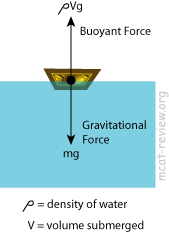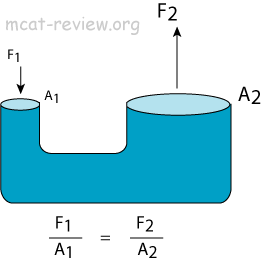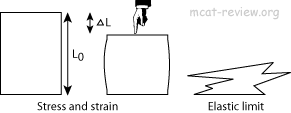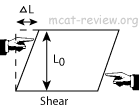|
|
Fluids
- Liquids and gases are fluids.
- Density, specific gravity
- Density: ρ=m/V, where ρ is density, m is mass, and V is volume.
- The density of water is ρwater = 1 g/mL = 1 g/cm3 = 1 kg/L.
- Specific gravity is the density of something compared to water.
- Specific gravity = ρ/ρwater.
- The specific gravity of water is 1.
- Buoyancy, Archimedes' principle

- Archimedes' principle: buoyant force on an object = weight of the fluid displaced by the object.
- FB = weightdisplaced = mdisplacedg =ρfluidVsubmergedg
- The volume of an object that is submerged = the volume of fluid displaced by the object.
- Things float when FB = Weight.
- Things will rise upward when FB > Weight.
- Things will sink when FB < Weight.
- Hydrostatic pressure
- Pascal's law: if you apply pressure on a liquid, the pressure is transmitted equally to all parts of the liquid.

- F1/A1 =F2/A2
- The pressure input at one end is the same as the pressure output at the other.
- You apply a small force over a small area, and the output force at the end with the larger area will be greater.
- A1d1=A2d2, where d is the distance that the end moves.
- The work done on one end is the same as the work output at the other.
- P = pgh (pressure vs. depth)
- P=ρgh
- P is pressure, ρ is the density of the fluid; g is the gravitational constant, h is the height from the surface, or depth that the object is submerged.
- Pressure at the surface is 0 because h = 0.
- Pressure at a depth of h is ρgh.
- ρgh is the gauge pressure because it ignores the atmospheric pressure above the fluid.
- Absolute pressure of something submerged in the ocean = ρgh + atmospheric pressure.
- Viscosity: Poiseuille flow
- When a viscous fluid flows through a pipe, the flow has a front that is shaped like a parabola bulging outward.
- Continuity equation (A·v = constant)
- The volume flow rate of a fluid is constant.
- dV/dt = constant, where dV/dt is volume flow rate.
- dV = A·dL
- A·dL/dt = A·v = constant, where v is linear flow rate (velocity).
- Concept of turbulence at high velocities
- Low velocity -> laminar flow.
- High velocity -> turbulent flow, forms eddies.
- Surface tension
- Surface tension gives the surface of a liquid the ability to support things that are very light.
- For example, insects can walk on water due to surface tension.
- Surface tension is due to the attraction between the molecules of the solvent.
- Bernoulli's equation
- P + ½ρv2 + ρgh = constant
Solids
- Density: ρ=m/V, where m is mass and V is volume.
- Elastic properties (elementary properties)

- Stress: the pressure exerted on an object. σ = stress = F/A.
- Strain: the deformation of the object in the direction of the applied force divided by the original length. ε = strain = ΔL/L0.
- Young's modulus = stress / strain.
- Young's modulus, the ratio between stress and strain, is constant until you reach the elastic limit, where things get permanently deformed.
- Elastic limit: The maximum stress something can handle before it breaks or become permanently deformed.
- Thermal expansion coefficient
- Things expand when temperature rises, and contract when temperature falls.
- ΔL = αL0ΔT
- ΔL is the change in length, L0 is the initial length, ΔT is the change in temperature, and α is the coefficient of linear expansion.
- In the same fashion as linear expansion, the equations for volume and area expansions are below.
- ΔV = βV0ΔT
- ΔA = γA0ΔT
- Shear

- Shear = stress / shear ratio.
- Shear ratio = ΔL/L0.
- When ΔL is very small compared to L0, Shear ratio is approximately the same as the shear angle.
- Shear angle = tan-1ΔL/L.
- Note: ΔL and L are perpendicular to each other.
- Compression: solids and liquids are generally not compressible. Gasses are compressible.
|
|
